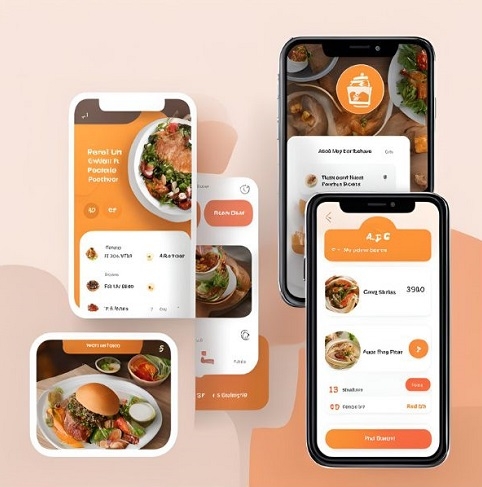Are you a small business owner looking to expand your reach and increase your revenue? One way to do that is by developing a food delivery app for your business. In this article, we will guide you through the process of creating a food delivery app tailored to the needs of small businesses.
Developing a food delivery app for small businesses involves several key steps, from research and planning to launch and maintenance. Here is a comprehensive guide on how to develop a food delivery app for small businesses:
The food delivery industry has seen exponential growth in recent years, with the global market expected to reach over $200 billion by 2027. This presents a significant opportunity for small businesses to expand their reach and tap into this lucrative market. Developing a custom food delivery mobile app can help small restaurants, grocery stores, and other food-based businesses provide a seamless ordering and delivery experience for their customers.
Importance of Food Delivery Apps for Small Businesses
Food delivery apps are crucial for small businesses to expand their reach and stay competitive in the market. These apps provide a convenient way for customers to order and receive food from their favorite restaurants, increasing customer satisfaction and loyalty.
Benefits of Developing a Food Delivery App
Increased Reach: Food delivery apps allow small businesses to reach a wider audience, including customers who may not have visited their physical location before.
Convenience: Customers can order food from the comfort of their homes, saving time and effort.
Revenue Growth: Food delivery apps can generate additional revenue through delivery fees, commissions, and premium services.
Data Insights: Apps provide valuable insights into customer behavior, preferences, and trends, enabling businesses to tailor their offerings and marketing strategies more effectively.
Overview of the Process
Developing a food delivery app involves several stages, including research and planning, design and development, testing and quality assurance, launch and deployment, and maintenance and updates.
Research and Planning
Market Research
1. Identifying Target Audience
· Demographics: Age, gender, location, and interests.
· Behavioral patterns: Online ordering habits and preferences.
2. Analyzing Competitors
· Market analysis: Competitor strengths and weaknesses.
· SWOT analysis: Strengths, weaknesses, opportunities, and threats.
Defining App Features
1. Basic Features
· User registration and profiles: Allow users to create accounts and manage their profiles.
· Menu browsing and ordering: Enable users to browse menus and place orders.
· Payment options: Offer various payment methods.
· Order tracking: Allow users to track their orders.
2. Advanced Features
· Loyalty programs: Reward frequent customers.
· Customization options: Allow users to customize orders.
· Integration with third-party services: Integrate services like maps, reviews, and social media.
Choosing the Right Technology Stack
1. Native vs Hybrid App Development
· Native apps: Built for specific platforms (iOS, Android).
· Hybrid apps: Use web technologies to build cross-platform apps.
2. Backend Infrastructure
· Server setup: Choose a suitable server and database.
· API integration: Integrate APIs for payment gateways and other services.
Design and Development
User Interface Design
1. Wireframing and Prototyping
· Wireframing: Create low-fidelity sketches.
· Prototyping: Create high-fidelity prototypes.
2. Branding and Visual Identity
· Logo design: Develop a unique logo.
· Color scheme: Choose a consistent color palette.
Frontend Development
1. Implementing User Interface Design
· Frontend framework: Choose a suitable framework (e.g., React, Angular).
· Coding: Write code to implement the design.
2. Testing for Usability and Functionality
· Usability testing: Test the app for ease of use.
· Functionality testing: Test all app features.
Backend Development
1. Setting Up Servers and Databases
· Server setup: Configure servers and databases.
· Database design: Design a suitable database schema.
2. Implementing App Features
· Backend framework: Choose a suitable framework (e.g., Node.js, Ruby on Rails).
· Coding: Write code to implement app features.
Integrating Third-Party Services
1. Mapping and Location Services
· Google Maps API: Integrate for location services.
· Other mapping services: Consider alternatives.
2. Payment Gateways
· Payment gateway integration: Integrate with payment gateways (e.g., Stripe, PayPal).
Testing and Quality Assurance
Unit Testing
1. Testing Individual Components
· Testing components: Test individual app components.
2. Identifying and Fixing Bugs
· Bug identification: Identify and fix bugs.
Integration Testing
1. Testing Interactions Between Different Modules
· Testing interactions: Test interactions between different app modules.
2. Ensuring Seamless User Experience
· User experience testing: Ensure a seamless user experience.
User Acceptance Testing
1. Involving Target Users for Feedback
· User feedback: Involve target users for feedback.
2. Making Necessary Improvements
· Improvement implementation: Implement necessary improvements.
Launch and Deployment
App Store Submission
1. Meeting Guidelines and Requirements
· App store guidelines: Ensure the app meets app store guidelines.
2. Creating App Store Listings
· App store listings: Create detailed app store listings.
Marketing and Promotion
1. Pre-Launch Strategies
· Pre-launch marketing: Plan pre-launch marketing strategies.
2. Post-Launch Campaigns
· Post-launch marketing: Plan post-launch marketing campaigns.
Monitoring and Support
1. Tracking App Performance
· App performance tracking: Track app performance metrics.
2. Providing Customer Support
· Customer support: Provide customer support services.
Maintenance and Updates
Regular Updates and Improvements
1. Bug Fixes and Performance Enhancements
· Bug fixes: Regularly fix bugs.
2. Adding New Features Based on Feedback
· Feature additions: Add new features based on user feedback.
Security and Compliance
Ensuring Data Protection
· Data security: Ensure data protection measures.
2. Adhering to Industry Regulations
· Regulatory compliance: Adhere to industry regulations.
Conclusion
Recap of the Benefits of Developing a Food Delivery App for Small Businesses
Developing a food delivery app offers numerous benefits, including increased customer reach, enhanced customer experience, competitive advantage, and valuable data insights.
Future Possibilities and Advancements in the Food Delivery Industry
The food delivery industry is constantly evolving, with advancements in technologies like AI-powered chatbots, augmented reality, and blockchain-based payment systems. These innovations can enhance the user experience and improve the overall efficiency of food delivery apps.
For more info: https://www.sigmasolve.com/contact/



